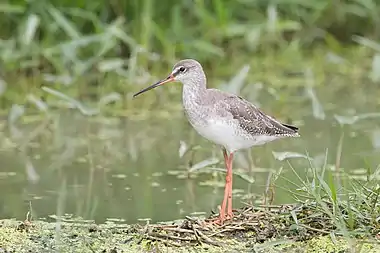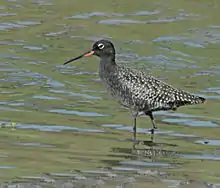Spotted redshank
The spotted redshank (Tringa erythropus) is a wader (shorebird) in the large bird family Scolopacidae. The genus name Tringa is the Neo-Latin name given to the green sandpiper by Aldrovandus in 1599 based on Ancient Greek trungas, a thrush-sized, white-rumped, tail-bobbing wading bird mentioned by Aristotle. The specific erythropus is from Ancient Greek eruthros, "red", and pous, "foot".[3]
| Spotted redshank | |
|---|---|
 | |
| Spotted redshank in non-breeding plumage | |
| Scientific classification | |
| Domain: | Eukaryota |
| Kingdom: | Animalia |
| Phylum: | Chordata |
| Clade: | Dinosauria |
| Class: | Aves |
| Order: | Charadriiformes |
| Family: | Scolopacidae |
| Genus: | Tringa |
| Species: | T. erythropus |
| Binomial name | |
| Tringa erythropus (Pallas, 1764) | |
 | |
| Range of T. erythropus (Compiled by: BirdLife International and Handbook of the Birds of the World (2016) 2007) Breeding Non-breeding Vagrant (seasonality uncertain) | |
| Synonyms | |
|
Totanus fuscus[2] | |
It breeds across northern Scandinavia and the northern Palearctic and migrates south to the Mediterranean, the southern British Isles, France, tropical Africa, and tropical Asia for the winter. It is an occasional vagrant to Australia and North America.
Taxonomy
The spotted redshank was described by German zoologist Peter Simon Pallas in 1764 and given the binomial name Scolopax erythropus.[4][5][6] It is a monotypic species, with no recognised subspecies.[7] Taxonomically, it forms a close-knit group with several other large Tringa species, with molecular sequencing showing it to be a sister clade to that containing the greater yellowlegs and the common greenshank.[8]
Description
This is a large wader (shorebird), measuring 29–31 cm (11–12 in) long,[nb 1] with a wingspan of 61–67 cm (24–26 in) and a weight ranging from 121 to 205 g (4.3 to 7.2 oz).[10] It is black in breeding plumage, and very pale in winter. It has a red legs and bill, and shows a white oval on the back in flight. Juveniles are grey-brown finely speckled white above, and have pale, finely barred underparts. Adults moult completely between July and October. In spring, the body plumage is moulted between March and May. Juveniles have a partial moult between August and February.[11] The call is a creaking whistle teu-it (somewhat similar to the call of a roseate tern), the alarm call a kyip-kyip-kyip.
Habitat and range
The spotted redshank breeds in the Arctic across much of the Palearctic, from Lapland in the west to Chukotskaya in the east.[8]
Behaviour
Food and feeding
Like most waders, it feeds on small invertebrates.
Breeding

It nests on open boggy taiga, laying four eggs in a ground scrape. For breeding the bird moults to a black to dark grey with white spots. During breeding plumage the legs also turn a dark grey. See image alongside.
Conservation and threats
The spotted redshank is one of the species to which the Agreement on the Conservation of African-Eurasian Migratory Waterbirds (AEWA) applies.
Notes
- By convention, length is measured from the tip of the bill to the tip of the tail on a dead bird (or skin) laid on its back.[9]
References
- BirdLife International (2015). "Tringa erythropus". IUCN Red List of Threatened Species. 2015: e.T22693207A67217485. doi:10.2305/IUCN.UK.2015-4.RLTS.T22693207A67217485.en.
- "synonyms of Tringa erythropus". Avibase. Retrieved 2021-11-04.
- Jobling, James A (2010). The Helm Dictionary of Scientific Bird Names. London: Christopher Helm. pp. 150, 390. ISBN 978-1-4081-2501-4.
- Peters, James Lee (1934). Check-list of Birds of the World. Volume 2. Vol. 2. Cambridge, Massachusetts: Harvard University Press. p. 264.
- Sherborn, C. Davies (1905). "The new species of birds in Vroeg's catalogue, 1764". Smithsonian Miscellaneous Collections. 47: 332–341 [340 No.306]. Includes a transcript of the 1764 text.
- Rookmaaker, L.C.; Pieters, F.F.J.M. (2000). "Birds in the sales catalogue of Adriaan Vroeg (1764) described by Pallas and Vosmaer". Contributions to Zoology. 69 (4): 271–277. doi:10.1163/18759866-06904005.
- O'Brien, Crossley & Karlson 2006, p. 357
- Parkin & Knox 2010, p. 173
- Cramp 1977, p. 3
- O'Brien, Crossley & Karlson 2006, p. 254
- RSPB Handbook of British Birds (2014). UK ISBN 978-1-4729-0647-2.
Sources
- Cramp, Stanley, ed. (1977). Handbook of the Birds of Europe, the Middle East and North Africa: Birds of the Western Palearctic. Vol. 1, Ostrich to Ducks. Oxford University Press. ISBN 0-19-857358-8.
- O'Brien, Michael; Crossley, Richard; Karlson, Kevin (2006). The Shorebird Guide. New York, NY: Houghton Mifflin. ISBN 0-618-43294-9.
- Parkin, David T.; Knox, Alan G. (2010). The Status of Birds in Britain and Ireland. London, UK: Christopher Helm. ISBN 978-1-4081-2500-7.
- Pereira, S.L.; Baker, A.J. (2005). "Multiple Gene Evidence for Parallel Evolution and Retention of Ancestral Morphological States in the Shanks (Charadriiformes: Scolopacidae)". Condor. 107 (3): 514–526. doi:10.1650/0010-5422(2005)107[0514:MGEFPE]2.0.CO;2. S2CID 86221767.
External links
- Chisholm, Hugh, ed. (1911). . Encyclopædia Britannica (11th ed.). Cambridge University Press.
- BirdLife species factsheet for Tringa erythropus
- "Tringa erythropus". Avibase.
- "Spotted redshank media". Internet Bird Collection.
- Spotted redshank photo gallery at VIREO (Drexel University)
- Interactive range map of Tringa erythropus at IUCN Red List maps
- Audio recordings of Spotted redshank on Xeno-canto.
- Tringa erythropus in Field Guide: Birds of the World on Flickr
- Spotted redshank media from ARKive
